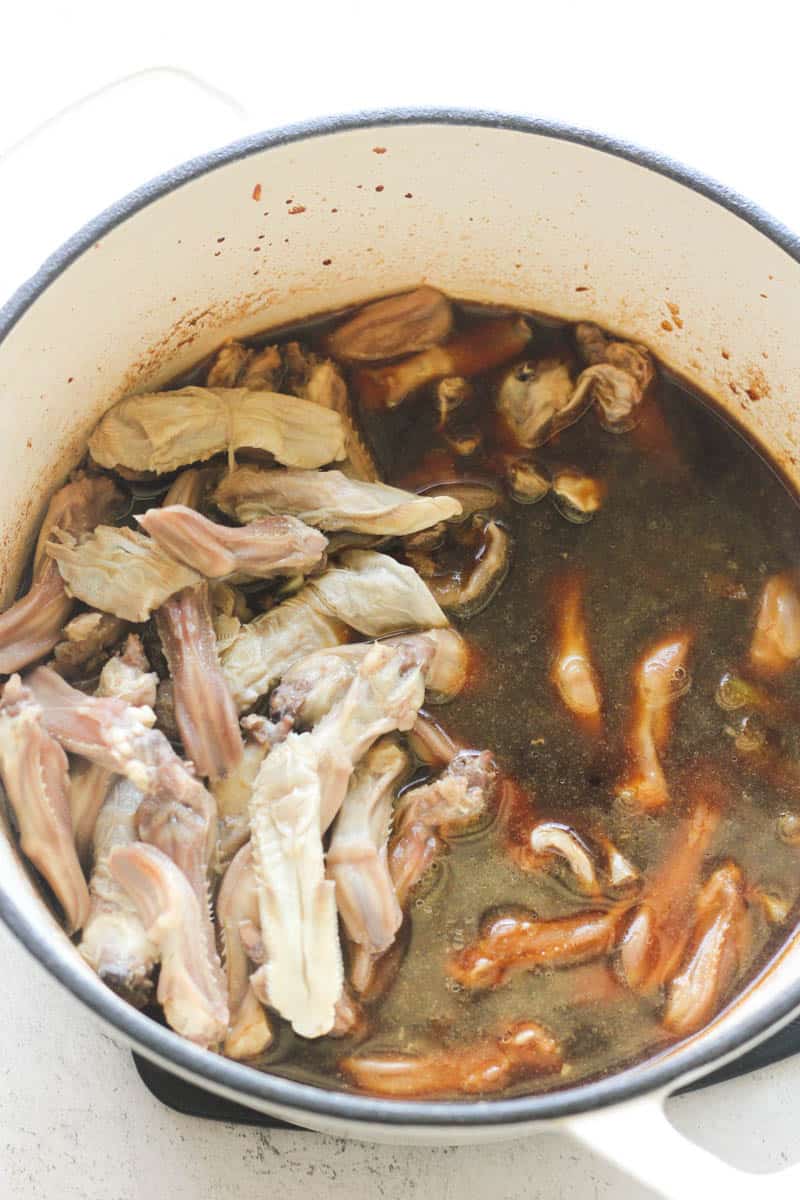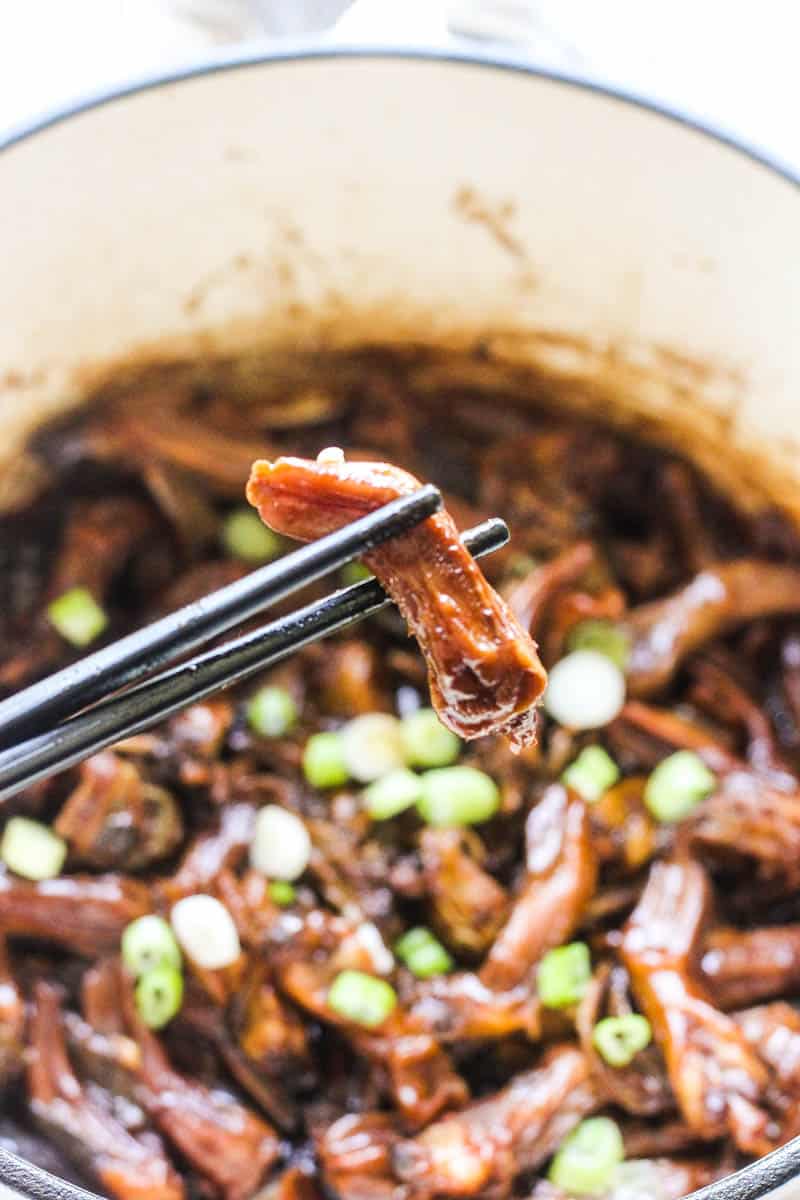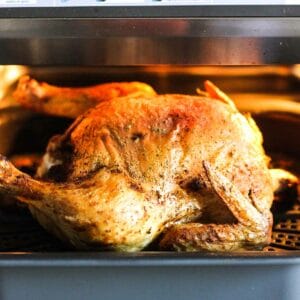This impressive duck tongue recipe is easier to make than you think! In this recipe, duck tongues are slow-cooked until tender and juicy in a Chinese-inspired sauce made with soy sauce, hoisin sauce, oyster sauce, and minced garlic. It's succulent, richly flavored, and melt-in-your-mouth delicious!

Duck tongue is a unique choice for dinner but if you never had it before you are in for a treat! If you love duck meat you are sure to enjoy duck tongue. It tastes like juicy duck meat but softer with pockets of fatty goodness. Love duck meat? More recipes for you to try: Air fryer duck and Duck gizzard recipe
This duck tongue recipe is simple to prepare but so flavorful that it will soon become a family favorite. It is bursting with flavor and is a wonderful lunch or dinner when served over steamed rice or tender noodles.
How to make duck tongue recipe
First, fill up your big pan, also known as a skillet or wok, with about 2 cups of water. Now, place it on the stove, turn on the heat, and wait for the water to bubble up - that's what we call boiling. Once the water looks all bubbly and steamy, you're going to carefully put the duck tongues into the hot water.
They're going to stay there for about 5 minutes, which we call blanching. Once the 5 minutes are up, you'll need to carefully take the duck tongues out of the water and let them rest on a plate for a little bit.

Next, you'll need to empty the hot water out of the skillet - make sure you get an adult to help because it will be very hot. Put the now-empty skillet back on the stove and pour in some cooking oil. Wait for the oil to get hot, then add the garlic, ginger, and green onions. Stir them around in the oil for about 2 minutes until they start to smell super yummy.
Then, it's time to add the soy sauce, cooking wine, Hoisin sauce, brown sugar, and chicken broth. Mix everything together really well. Now, the duck tongues get to go back in the skillet. Give them a good stir so they're all coated in the sauce.
Put a lid on the skillet and turn the heat down really low. This is when the duck tongues are going to simmer, which means they'll cook really slowly in the sauce for about 30 minutes.
After that, you'll need to take the lid off and let the duck tongues cook for another 15 minutes. This will make the sauce thicker and even tastier.

And there you have it! You've just cooked up a delicious dish of duck tongues. Remember to always have an adult nearby when you're cooking, especially when you're working with hot things. Happy cooking!
Recipe ingredients
Duck tongues. 1 lb fresh or defrosted. You can take the bones out of them if you like or leave them in for a nice crunch.
Vegetable oil. Used to gently fry the aromatics until fragrant.
Minced garlic, ginger, and green onions. The aromatics are fried in oil to give this dish a deeper depth of flavor.
Soy sauce, oyster sauce, cooking wine, and hoisin sauce. Adds Asian-inspired flavor to the sauce.
Brown sugar. A little bit is used to add a light caramel sweetness.
Chicken broth. One of the main ingredients in this sauce. Adds extra savory flavor.
White pepper. Has a subtle musty and earthy flavor that pairs well with the other ingredients.

What are they and how to clean them
If you are new to eating duck tongue it is very unlike cow's tongue which is mostly muscle and can be thick, meaty, and very chewy. Duck tongue, on the other hand, are very small, soft, and slightly chewy. It is juicy and contains a small amount of meat.
Another unique thing about duck tongue is that it has an edible soft bone running down the middle of it. This bone can be eaten or removed. It is made of mostly cartilage and when eaten adds a soft crunch to every bite!
Would you like to save this?
There are two main ways to clean duck tongues. They can be rinsed under cool running water to remove any debris, or you can blanch them in boiling hot water. I like to do this to make sure the tongues are extra clean and it helps to tenderize the tongues so that they cook quicker!

Substitutions
Chicken broth. Beef or veggie broth, or a couple of bouillon cubes and 2 cups of water.
White pepper. Pink or multi-colored pepper or ground mustard.
Soy sauce. Tamarind can be used instead.
Oyster sauce. Use fish sauce.
Hoisin sauce. Substitute with more soy sauce, a bit of miso paste, or a mixture of barbecue sauce and a tiny bit of molasses.
Cooking wine. You can use regular dry red wine or equal parts red wine vinegar and water.

Frequently asked questions
Duck tongue tastes like duck meat. It's very small with a rich flavor and fatty melt-in-your-mouth texture.
Yes! The bone in the center of the duck tongue is mostly cartilage and not a true bone. It's totally edible and gives a slight crunch.
Duck tongues can be deep-fried and eaten as a tasty snack or party appetizer. It can also be used to make duck tongue tacos or slowly braised in a flavorful sauce like in this recipe and eaten for lunch or dinner with rice or noodles!
If you decide to remove the bone, simply hold the tongue in one hand then with the other hand pinch and pull out the bone starting from the tip. This is easier to do when the tongues have been blanched first.
Duck tongues are quite affordable and can be found in large bags at most Asian grocery stores or online meat delivery services.

Side dishes
- Stir-Fried Vegetables and White Rice: This is a simple and healthy side dish. Stir-fry some of your favorite vegetables such as bell peppers, broccoli, carrots, and snap peas in a bit of sesame oil. Season with a little soy sauce, sesame seeds, and serve it with white rice. The lightness of the vegetables and rice will balance out the rich flavor of the duck tongues.
- Cucumber Salad: This is a refreshing and crunchy side dish that can complement the rich flavors of duck tongues. Simply slice cucumbers, toss them in a dressing made of rice vinegar, soy sauce, sesame oil, and a pinch of sugar, then sprinkle some sesame seeds on top.
- Fried Rice: Transform your plain white rice into something more flavorful. Fry it up with some vegetables like peas and carrots, add a bit of soy sauce, and scramble an egg into it. It’s a more flavorful companion to your duck tongues.
- Steamed Bok Choy with Garlic Sauce: Bok Choy's mild flavor won't overshadow the duck tongues. Simply steam the bok choy until it's tender, then drizzle with a sauce made of garlic, soy sauce, and a bit of oyster sauce.
Recipe pro tips
- Use a Non-stick Skillet: This will prevent the duck tongues and the sauce from sticking to the pan and burning. It'll make the cooking process much easier and the cleaning up afterwards less of a chore.
- Always Preheat the Pan: Before adding the oil and the other ingredients, make sure the skillet is properly preheated. This will ensure even cooking and help the ingredients to release their flavors more effectively.
- Don't Rush the Blanching Step: The blanching step in the recipe is crucial as it helps to remove any potential strong flavors from the duck tongues. Make sure you give it a full five minutes for the best results.
- Regularly Stir the Sauce: Once all the ingredients are in the skillet, make sure to give them a regular stir. This helps the sauce to cook evenly, preventing it from sticking or burning at the bottom of the pan, and ensures all the duck tongues are well-coated and flavorful.

Storage instructions
For storing:
- Wait until the duck tongues have completely cooled down, but don't let them sit out for more than two hours.
- Put the cooled duck tongues into a sealable bag or a container that can be closed really tightly.
- If you're going to eat the duck tongues in a couple of days, keep them in the fridge. If you need them to last longer, put them in the freezer. They can be kept in the freezer for up to three months.
For reheating:
- If you've frozen the duck tongues, you should move them from the freezer to the fridge the night before you want to eat them so they can thaw out.
- When you're ready to eat the duck tongues, warm them up in a skillet over medium heat. Add a splash of water or broth to stop them from drying out.
- Keep stirring the duck tongues while they heat up so they get warm evenly. Once they're hot, stop heating them because heating them for too long can make them tough.
You may also like
- Air fryer duck breast
- Air fryer duck legs
- Salmon head recipe
- Pork tongue recipe
- Lamb heart recipe
- Chicken hearts recipe
- Pork liver recipe
- Slow cooker beef heart recipe
Hope you will like this duck tongue recipe as much as we do. Please rate the recipe if you made it and leave a comment below if you have any questions or suggestions.

Duck Tongue Recipe
This impressive duck tongue recipe is easier to make than you think! In this recipe, duck tongues are slow-cooked until tender and juicy in a Chinese-inspired sauce made with soy sauce, hoisin sauce, oyster sauce, and minced garlic. It's succulent, richly flavored, and melt-in-your-mouth delicious!
Ingredients
- 1 lb duck tongues
- 1 tablespoon oil
- ¼ cup soy sauce
- ¼ cup cooking wine
- ¼ cup oyster sauce
- ¼ cup Hoisin sauce
- 2 cups low-sodium chicken broth
- 4 slices fresh ginger, about ¼-inch thick
- 3 cloves garlic, minced
- 2 green onions, cut into 1-inch pieces
- ½ teaspoon white pepper
Instructions
- Boil about 2 cups of water in the skillet or wok and blanch them for 5 minutes. Drain tongues and set aside.
- Heat oil in the same skillet and add garlic, ginger and green onions. Cook for 2 minutes, add soy sauce, cooking wine, Hoisin sauce, brown sugar and chicken broth. Add duck tongues.
- Cover and simmer on low heat for 30 minutes. Take the lid off and cook for another 15 minutes.
Notes
Nutrition Information:
Yield: 5 Serving Size: 1Amount Per Serving: Calories: 425Total Fat: 30gSaturated Fat: 9gTrans Fat: 0gUnsaturated Fat: 18gCholesterol: 79mgSodium: 1730mgCarbohydrates: 17gFiber: 2gSugar: 5gProtein: 20g





Leave a Reply